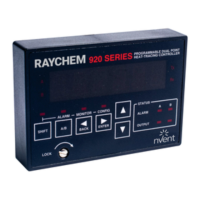52 / 82
EN- Raychem920series-IM-H5687405/15
INDUSTRIAL HEAT TRACING SOLUTIONS
5.4 TEMPBUS™ CONTROL MODE
TEMPBUS™ is short for Temperature Bus. This refers to a connection that allows one “master”
HTC to share its control temperature with a number of “slave” HTCs. Up to 25 “slave” HTCs can be
connected to this bus. Refer to the wiring diagrams in Appendix C for example con-nection details.
5.4.1 TEMPBUS™ MASTER
Only Point A of a 920 HTC can be configured as a TEMPBUS™ “master.” A TS CONTROL MODE
using either TS 1 and/or TS 2 should be selected and the EXTERNAL OUTPUT should be set to
TEMPBUS™. This will cause the measured control temperature of Point A to be sent out the
EX-TERNAL OUTPUT port.
IMPORTANT:
• IfaTEMPBUS™“master”hasitstemperaturecontroloverriddenbyanINHIBIToverrideora
FORCE ON override signal, it will pass this override signal over the TEMPBUS™ to its “slaves.”
• Loadshedding,fail-safe,orauto-cyclingconditionsarenotpassedovertheTEMPBUS™froma
“master” to its “slaves.”
5.4.2 TEMPBUS™ SLAVE
Both Point A and/or Point B of a 920 HTC can be configured as a TEMPBUS™ “slave.” The
EXTERNAL INPUT should be set to TEMPBUS™, then the point’s TS CONTROL MODE must be set
to a mode using the EXTERNAL INPUT. The “slave” controller will perform its own temperature
con-trol using the control temperature of the “master.”
If a TEMPBUS™ “slave” does not receive a control temperature from a TEMPBUS™ “master” at
least once every 15 seconds, then a CONTROL TS FAILURE ALARM will occur. This alarm is non-
latching for TEMPBUS™ “slaves” and will be cleared automatically once a control temperature is
received again. Point B can be a “slave” to Point A of the same controller.
IMPORTANT: Other features that require the use of the EXTERNAL INPUT (INHIBIT or OVERRIDE)
may not be used at the same time as the TEMPBUS “slave” feature.

